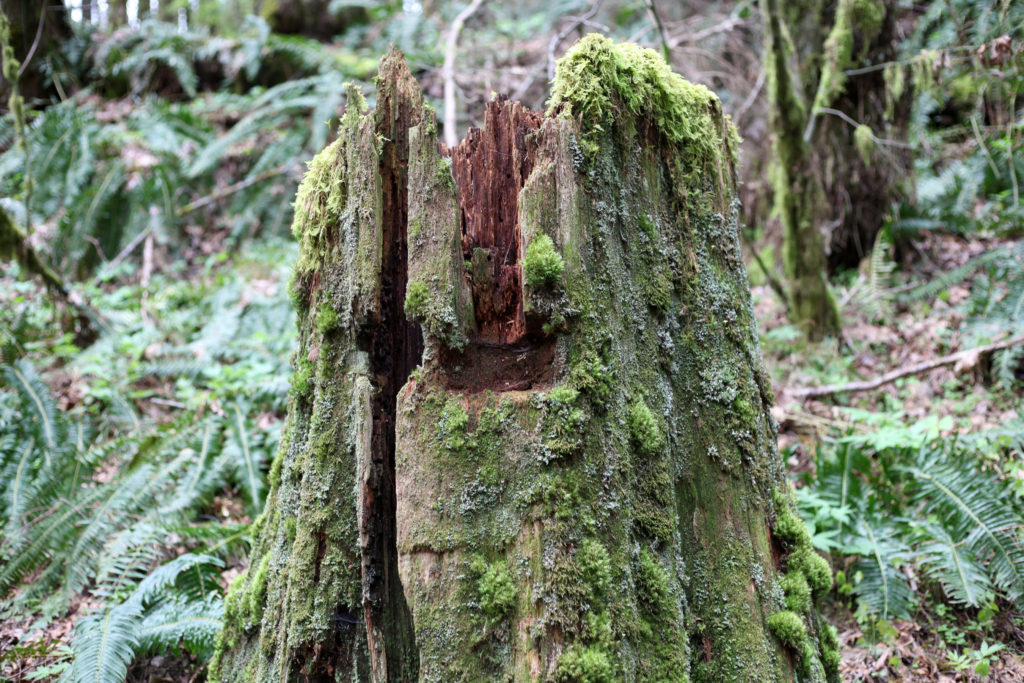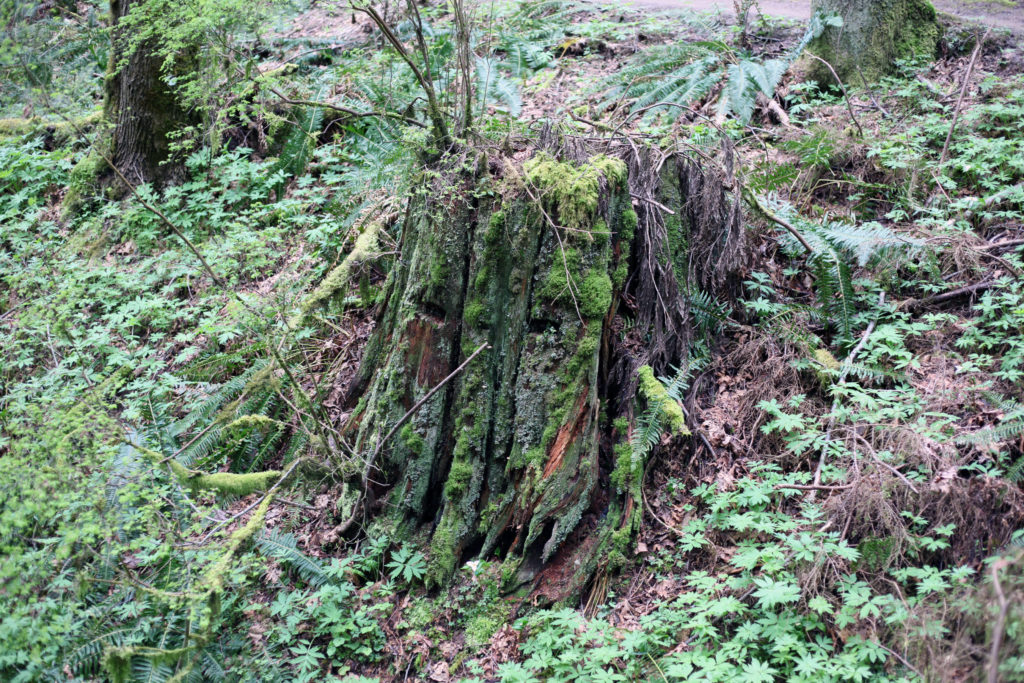Today the loudest noises you’re likely to hear in Forest Park are bird sounds, whether it’s crows chattering, a woodpecker tapping, or a wren practicing its aria. There was once a time, though, when the slopes of Forest Park would have echoed with the sounds of axes and two-person handsaws and shouts of “TIMBER!” Those shouts would have been followed by a terrifying noise that one observer described as a ‘roar’ that sounded like “the heaviest artillery, or like the blast of thunder from a near-striking bolt,” as centuries-old trees came crashing to the ground.
The Forest Park we know today is an ecologically diverse forest that stretches as far as the eye can see. It might come as a surprise to some readers that nearly all of Forest Park was logged between 1850 and 1948, the year the park was established.
Up until the 19th century virtually all of Forest Park was old-growth forest—a stable, self-sustaining forest with giant, fully mature conifer trees. That abruptly changed in the 1850s, as Euro-American settlers divided Forest Park into land claims and began cutting down trees.

What started out as small-scale logging by individuals later gave way to large-scale commercial logging operations that resulted in the loss of most of the original old-growth forest. Many areas of the park underwent several rounds of logging, as second-growth trees that replaced the old growth were also cut down. These trees literally fueled Portland’s growth in the 19th century, as the wood was used to power steamships, heat homes, and build Portland’s early skyline.
All of this might seem hard to imagine in 21st-century Portland, but Portland was a timber town long before it was a Timbers town, and the nickname Stumptown was originally descriptive—Portland started out as a clearing in the woods. Logging was a welcome source of income for many who arrived in the area and needed work, and many downtown businesses (notably Erickson’s Saloon on West Burnside) catered largely to loggers. It’s also said that Portland’s famous Benson Bubblers were originally installed to give thirsty loggers an alcohol-free alternative to the saloons.
Occasionally you’ll see stumps with oblong notches that measure several inches across. These are called springboard notches, and they’re important evidence of how loggers cut down many of the trees in Forest Park. The loggers cut these notches into the tree in order to hold the ends of special planks—called springboards—securely in place. The loggers would stand on the springboards while they chopped and sawed away at the trees. Since the trees were usually quite thick and the loggers only had hand tools, they would typically work in teams of two and chop and saw from two sides of the trunk.
Forest Park Established in 1948
The creation of Forest Park in 1948 brought an end to logging within the park boundaries, but you can still see evidence of logging when you’re out on the trails. The most obvious clue is the tree stumps that can be seen throughout the park. Some of the stumps are significantly wider than the trees growing around them today and can help us appreciate the scale of the trees that once towered overhead. You’d see even more stumps in the park today if it weren’t for 19th-century logging practices, which often involved clear-cutting followed by slash burning. This would leave the logged areas completely bare of vegetation until new growth emerged.

You might wonder how the loggers escaped once the tree started falling, especially since the springboard notches are often six or more feet off the ground. The answer is that these loggers were experienced professionals whose lives depended on knowing which way the tree would fall. They would listen for the final crack, and as soon as the tree gave way the loggers would throw down their tools and use the springboards like diving boards to jump out of harm’s way. Logging wasn’t a job for the faint of heart!
Today’s Forest Park
According to Portland Parks & Recreation, only 0.5 percent of Forest Park is now old-growth forest. In contrast, almost three-quarters of the park is second-growth forest that only began growing after logging ended 70 years ago. Those areas of the park are easy to recognize because the trees are mostly deciduous species like bigleaf maple and red alder. Other areas of the park were last logged over 100 years ago and have had more time to regenerate. In those areas Douglas firs have already replaced maples and alders as the most common tree, and it’s predicted that this transformation will take place across most of Forest Park over the next few decades.
Despite a century of logging, the forest is making a strong recovery and—as long as we continue protecting Forest Park—it can become 100 percent old growth again in a few hundred years.
For more information
The first paragraph quotes a first-hand account of early 20th-century logging by the journalist and editor C. C. Chapman.You can access the complete article here.
To learn more about springboards and springboard notches I recommend this article on the Tryon Naturalist Notes website.
Chris Knutson is an archaeologist and regular FPC volunteer.

